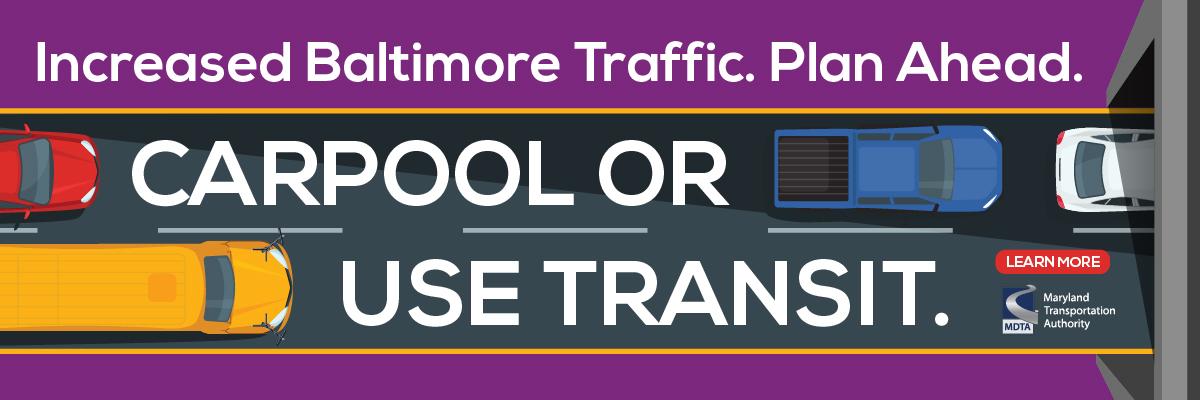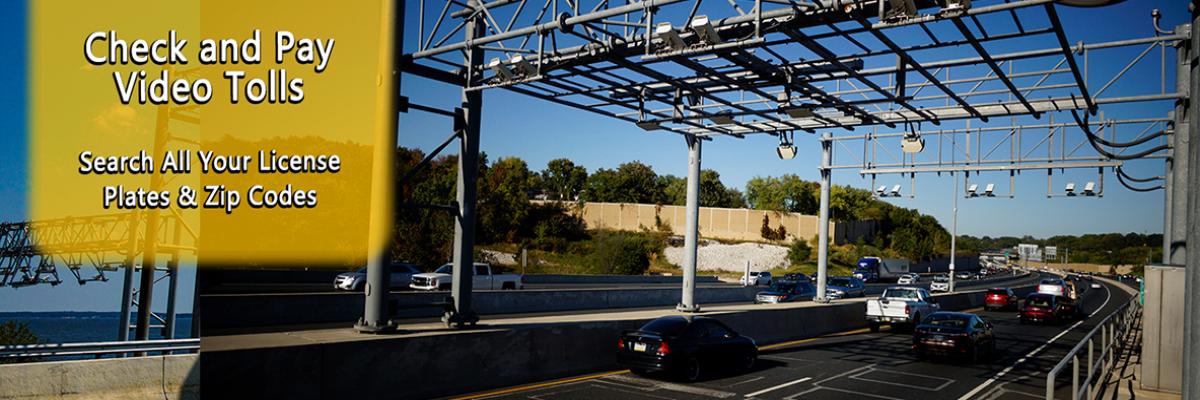Governor Harry W. Nice Memorial Bridge

Sustainability Initiatives
Environmental and Sustainability Oversight Committee (ESOC)In 2010, the Environmental and Sustainability Oversight Committee (ESOC) was established to coordinate and manage the agency's environmental and sustainability requirements and initiatives. This multi-divisional group meets monthly to share information and evaluate projects in terms of sustainable development.
Energy Conservation:
The MDTA understands that every effort -- even small ones -- can have a huge impact on reducing energy and saving money. Our efforts include the following:
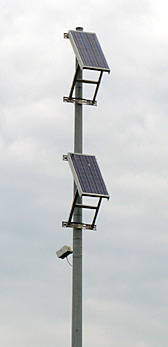
Solar panels in use along
I-95 just north of the
Fort McHenry Tunnel.
- Retrofitted 8,680 fluorescent fixtures with light-emitting diode (LED) fixtures at the Fort McHenry Tunnel (I-95).
- Installed a simplified version of an Energy Management Control System (EMCS) to reduce electrical energy consumption and demand.
- Eliminated the use of potentially dangerous personal space heaters following an assessment of employee needs.
- Evaluating converting parking lot and other High Intensity Discharge (HID) light fixtures with LED fixtures. This conversion, where feasible, could result in wattage reductions from 400 to 100 watt units in some areas and a lamp life of 100,000 hours versus the current fixtures, which offer half that amount.
- Investing in solar panel light fixtures for warning signs located at ramp entrances and assessing its use in other areas, including bridge lighting, where solar or LED lights also may be utilized safely.
- Investigating the use of Plug Load Controls (PLC), which automatically shut off power to electrical equipment (computers, monitors, printers, calculators, task/desk lights, fans, etc.) while employees are away from their desks for an extended period of time.

Fort McHenry Tunnel LED lighting test zone.
Materials and Waste Management
Materials and waste management initiatives allow the MDTA to control the materials it uses on a daily basis and limit its impact on the environment. From recycling programs and solid-waste management, to storing equipment and handling hazardous materials properly, MDTA employees prove each day that they are committed to performing their duties in an environmentally responsible manner.
As mandated by the Maryland Recycling Act (MRA), the MDTA office employees recycle paper products, glass and plastic bottles, aluminum and bi-metal cans, and cardboard and make every effort to reuse items. Over recent years, the MDTA has strived to achieve the minimum recycling rate of 15% to 30%. For 2012, the MDTA's recycling rate was 30.9%. A breakdown by facility is presented below:
| 2012 MRA Recycling rate | MDTA Facility Name |
| 78.4% | Intercounty Connector |
| 47.5% | Thomas J. Hatem Memorial Bridge |
| 43.7% | John F. Kennedy Memorial Highway Maintenance Two |
| 40% | JFK Administration/I-95 Weigh & Inspection Station |
| 32% | Baltimore Harbor Tunnel |
| 27.9% | John F. Kennedy Memorial Highway Maintenance One |
| 19.8% | Fort McHenry Tunnel |
| 16.2% | Governor Harry W. Nice Memorial Bridge |
| 15.7% | William Preston Lane, Jr. Memorial Bridge |
| 10.1% | Point Breeze Office Complex |
| 8.3% | Francis Scott Key Memorial Bridge |
In addition, MDTA roadway and automotive maintenance employees practice recycling and ensure non-recyclable materials are properly disposed. These practices include:
- Recycling items collected during roadside maintenance, such as curb sweeper dirt, landscaping trimmings, rubber tires, and scrap metal.
- Recycling materials generated by automotive maintenance, such as used oil, sludge, and non-hazardous antifreeze.
- Hazardous wastes, even those considered to be "household hazardous waste," are not discarded as general refuse. Some materials (i.e., alkaline batteries) are recycled, while others are properly managed for disposal.
- The MDTA's housekeeping and maintenance staffs ensure that no trash or debris is maintained or stored outside of their properly marked dumpsters.
- External trash-collection containers are equipped with lids to prevent rain water from picking up residue or debris and contaminating the State's stormwater.
As is evident from the efforts noted above, the MDTA's recycling efforts are a vital part of the agency's environmental sustainability initiatives -- and can even reduce agency costs! For example, with our garbage-hauling contractor paid on a per pick-up basis, recycling materials means less waste and less trips to our facilities.
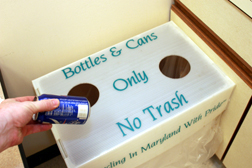
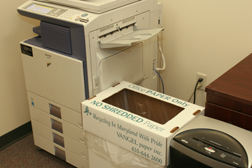
Easily accessible recycling bins for bottles, cans and paper.
Fuel Management & Alternative Fuels
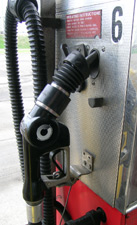 The MDTA has nine fueling stations - located in Anne Arundel, Baltimore, Cecil, Charles, and Harford counties and Baltimore City -- that may be used by State employees driving a vehicle issued from the State's automotive pool. MDTA facilities
The MDTA has nine fueling stations - located in Anne Arundel, Baltimore, Cecil, Charles, and Harford counties and Baltimore City -- that may be used by State employees driving a vehicle issued from the State's automotive pool. MDTA facilities 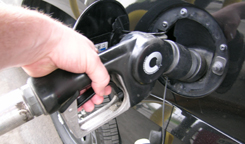 are equipped with underground storage tanks and above-ground storage tanks that contain diesel, biodiesel, gasoline and ethanol (E85). To manage our fuel properly and prevent discharges of oil to navigable waters and the environment, the MDTA has developed Spill Prevention, Control and Countermeasures (SPCC) Plans. In November 2009, the MDTA opened its very first E85 fueling station at the Baltimore Harbor Tunnel maintenance facility.
are equipped with underground storage tanks and above-ground storage tanks that contain diesel, biodiesel, gasoline and ethanol (E85). To manage our fuel properly and prevent discharges of oil to navigable waters and the environment, the MDTA has developed Spill Prevention, Control and Countermeasures (SPCC) Plans. In November 2009, the MDTA opened its very first E85 fueling station at the Baltimore Harbor Tunnel maintenance facility.
Stormwater Management
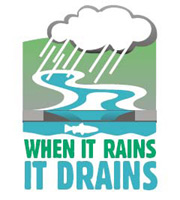 Stormwater runoff is rainfall that travels off impervious surfaces like roads and rooftops and drains into the watershed by traveling over ground or through storm drains. Along the way, the stormwater gathers pollutants lying on the surface including oil, pesticides, sediment, and trash. An increase in impervious surfaces creates a higher volume of stormwater runoff that moves at a faster rate.
Stormwater runoff is rainfall that travels off impervious surfaces like roads and rooftops and drains into the watershed by traveling over ground or through storm drains. Along the way, the stormwater gathers pollutants lying on the surface including oil, pesticides, sediment, and trash. An increase in impervious surfaces creates a higher volume of stormwater runoff that moves at a faster rate.
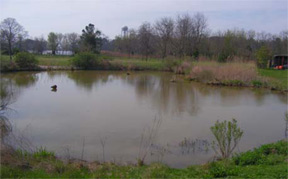
Bay Bridge Stormwater Containment Pond
The MDTA is committed to managing stormwater and has initiated efforts to reduce stormwater runoff and pollution into the Chesapeake Bay and its tributaries, including: developing a Geographic Information System (GIS) database and mapping system of our stormwater drainage network, building and maintaining Stormwater Management Facilities to treat, retain and promote infiltration; developing facility Pollution Prevention Plans, installing silt fences on construction sites; taking precautions to prevent fuel leaks; and controlling and limiting pesticide applications.
FHWA Award-Winning Asquith Creek Oyster Reef Project

The Chesapeake Bay Foundation's "Patricia Campbell" seeding Oyster Spat
(juvenile oysters) on the Asquith Creek reef site.
In fall 2008, the MDTA partnered with the Department of Natural Resources (DNR) and numerous partners to create the Asquith Creek Oyster Reef. This unique public-private partnership was recognized with a Federal Highway Administration Exemplary Ecosystem Initiative Award for its sustainable transportation and environmental protection that is now providing an oyster sanctuary with the sole purpose of improving the quality of water flowing into the Chesapeake Bay. The MDTA and DNR joined their partners, including the Chesapeake Bay Foundation and the Maryland Legislative Sportsmen's Foundation, to create the three-acre oyster reef with four million juvenile oysters and demolished concrete from the Bay Bridge Preservation Project.


